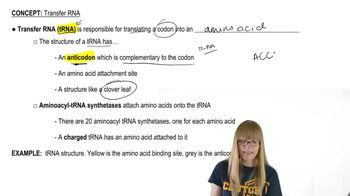Table of contents
- 1. Introduction to Genetics51m
- 2. Mendel's Laws of Inheritance3h 37m
- 3. Extensions to Mendelian Inheritance2h 41m
- 4. Genetic Mapping and Linkage2h 28m
- 5. Genetics of Bacteria and Viruses1h 21m
- 6. Chromosomal Variation1h 48m
- 7. DNA and Chromosome Structure56m
- 8. DNA Replication1h 10m
- 9. Mitosis and Meiosis1h 34m
- 10. Transcription1h 0m
- 11. Translation58m
- 12. Gene Regulation in Prokaryotes1h 19m
- 13. Gene Regulation in Eukaryotes44m
- 14. Genetic Control of Development44m
- 15. Genomes and Genomics1h 50m
- 16. Transposable Elements47m
- 17. Mutation, Repair, and Recombination1h 6m
- 18. Molecular Genetic Tools19m
- 19. Cancer Genetics29m
- 20. Quantitative Genetics1h 26m
- 21. Population Genetics50m
- 22. Evolutionary Genetics29m
11. Translation
Translation
Problem 39e
Textbook Question
Answer the following questions about the accompanying diagram.

What name is given to the object looking like a string of beads that is closest to F?
 Verified step by step guidance
Verified step by step guidance1
Identify the components in the diagram: A is DNA, B is RNA polymerase, C is mRNA, D is ribosome, E is tRNA, F is the polypeptide chain, and G is the growing polypeptide chain.
Focus on the object labeled F, which is depicted as a string of beads.
Recognize that the string of beads represents a polypeptide chain, which is a sequence of amino acids linked together.
Understand that the polypeptide chain is being synthesized by the ribosome (D) as it translates the mRNA (C).
Conclude that the object looking like a string of beads closest to F is the polypeptide chain.
 Verified video answer for a similar problem:
Verified video answer for a similar problem:This video solution was recommended by our tutors as helpful for the problem above
Video duration:
1mPlay a video:
Was this helpful?
Key Concepts
Here are the essential concepts you must grasp in order to answer the question correctly.
Translation
Translation is the process by which ribosomes synthesize proteins using messenger RNA (mRNA) as a template. During translation, the ribosome reads the sequence of codons in the mRNA and assembles the corresponding amino acids into a polypeptide chain. This process is essential for gene expression and the production of proteins that perform various functions in the cell.
Recommended video:
Guided course

Translation initiation
Ribosome
The ribosome is a complex molecular machine found within all living cells that facilitates the translation of mRNA into proteins. It consists of ribosomal RNA (rRNA) and proteins, forming two subunits that come together during protein synthesis. The ribosome moves along the mRNA strand, ensuring that the correct amino acids are added in the proper sequence to form a functional protein.
Recommended video:
Guided course

Ribosome Structure
Amino Acids
Amino acids are organic compounds that serve as the building blocks of proteins. There are 20 different amino acids that combine in various sequences to form proteins, each with unique properties that determine the protein's structure and function. In the context of translation, amino acids are brought to the ribosome by transfer RNA (tRNA) molecules, which match their anticodons to the codons on the mRNA.
Recommended video:

 7:58m
7:58mWatch next
Master Translation initiation with a bite sized video explanation from Kylia Goodner
Start learning




